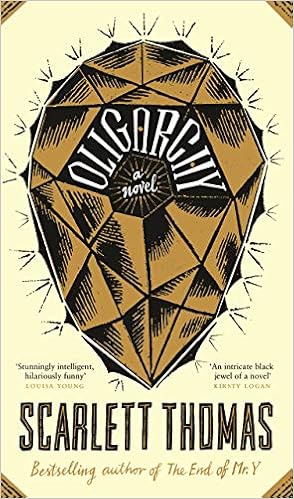The novel focuses on Tash (Natasha), the daughter of a Russian
oligarch, who arrives at an English girls’ boarding school. Life at the school seems to revolve around
eating or, rather, not eating: “90 per cent
of the school has some sort of eating disorder.” One girl dies and her death is ruled a
suicide, but Tash suspects she was murdered and sets out to uncover the truth.
The title refers to the school which is a perfect example of an
oligarchy, government by the few. In the
school, the thin girls, the popular girls, rule. Only those who become obsessed with weight
loss and body image are accepted. They
even take turns inventing strict diets for the other girls to follow: “On Monday everyone starts a new diet. It’s Lissa’s invention. The diet is this: wholewheat bread and Sandwich Spread
only. No butter. Vegetables are allowed but no fruit.”
It is possible to have some sympathy for the girls. They are rich but are virtually abandoned by
their parents. Tash, for example, never
sees her father; the parental figure in her life is her Aunt Sonja who tells
her, “Do everything you can to keep your beauty. Exams are not important” and warns her, “if
you put the weight on once you will never, ever take it off. Well, you can do it temporarily, but once it
has been there it will always long to return, like a missing lover, like a weed,
like a boy gone to the army.”
The problem, however, is that it is difficult to like the girls. They laugh at what they consider to be the
pathetic lives of regular people whom they call “plebs”. A teacher tells them, “You’re all so shallow
and annoying” and that description is perfect.
None of the girls really emerges as a round character with a distinct
personality; they are just mean, privileged girls who are fixated on body image
and consumerism. As a result, the reader
may not feel as much sympathy for them as the author might want.
There are some other aspects that did not appeal to me. The structure is rather choppy with a lack of
smooth transitions. The style is
emotionless. A plot is almost
non-existent. Why is the word “fluorescence”
repeated 13 times?
At times, this book seems to read more like Young Adult fiction: “Tiffanie gets out a Sherbet Fountain which
she calls a ‘dib-dob’ and “Bianca has secretly joined a Pro Ana WhatsApp group
and . . . does not TePe daily.” It is,
however, not a book I would want to give to a young person dealing with eating
problems or body image issues.
On the other hand, I don’t think I’m the target audience for the book
either. Maybe because I’m a “pleb”, I
just can’t empathize enough with these uber-wealthy, superficial, nasty girls
who are so pre-occupied with false values.
Note: I received a digital galley from the publisher via NetGalley.

No comments:
Post a Comment